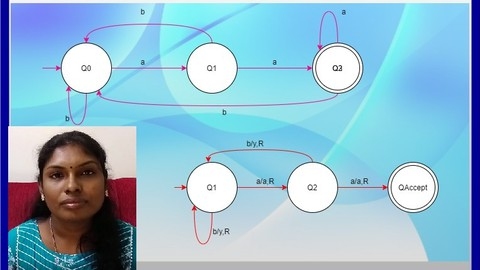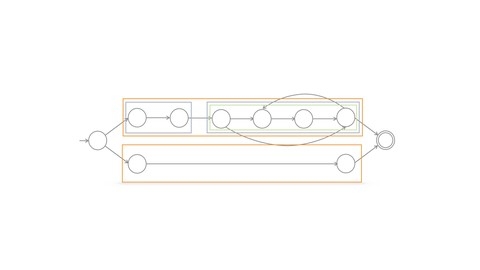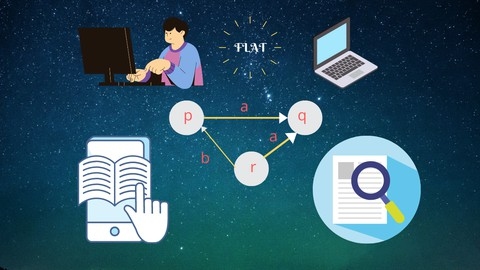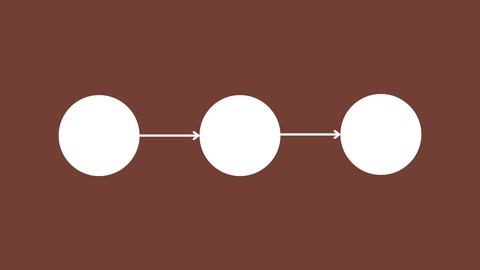Automata theory is a fundamental branch of computer science that explores the theoretical underpinnings of computation and formal languages.
Understanding automata theory allows you to delve into the complexities of programming languages, design efficient algorithms, and analyze the computational power of various machines.
From understanding the basics of finite automata to exploring the power of Turing machines, mastering this subject can open doors to exciting opportunities in diverse fields like software engineering, theoretical computer science, and artificial intelligence.
Finding a suitable automata theory course on Udemy can be a daunting task, given the vast number of options available.
You’re looking for a course that’s comprehensive, engaging, and taught by experts, but also caters to your learning pace and objectives.
Don’t worry, we’ve got you covered!
For the best automata theory course overall on Udemy, we recommend Theory of Computation(TOC) / Automata : Complete Pack.
This comprehensive course delves deep into the fundamentals of automata theory and formal languages, covering topics like regular languages, deterministic and non-deterministic finite automata, pushdown automata, and Turing machines.
It features numerous examples, exercises, and real-world applications, making it an ideal choice for both beginners and those seeking to strengthen their knowledge.
While this is our top pick, other excellent courses are available that might better suit your learning style and goals.
Keep reading to discover our recommendations for different learning levels, areas of specialization, and learning preferences.
Theory of Computation(TOC) / Automata : Complete Pack
This course covers the fundamentals of automata theory and formal languages in depth.
You’ll start with an introduction to the theory of computation and formal languages, learning about concepts like alphabets, strings, languages, and grammars.
From there, the course dives into regular languages and different types of automata that recognize them.
You’ll learn how to construct deterministic finite automata (DFAs) and non-deterministic finite automata (NFAs) for various regular languages.
The examples cover a wide range of scenarios, from simple languages like strings starting or ending with certain patterns to more complex ones involving numerical properties.
The course also teaches you how to convert NFAs to DFAs using algorithms like subset construction.
You’ll explore the complementation of regular languages and learn to construct regular expressions for given languages.
Moving beyond regular languages, you’ll study pushdown automata (PDAs) and their ability to recognize context-free languages.
Numerous examples illustrate how to design PDAs for different language constraints involving counting, equality, and patterns of multiple symbols.
Finally, the course covers the powerful Turing machines, which can recognize any recursively enumerable language.
You’ll learn how to construct Turing machines for languages involving operations like concatenation, repetition, and arithmetic on unary numbers.
The examples even include more advanced languages like palindromes and square strings.
Throughout the course, you’ll gain insights into the Chomsky hierarchy and the expressive power of different automata models.
The systematic examples and exercises will help you develop a solid understanding of automata theory’s core concepts and their applications.
Introduction to Automata Theory, Languages and Computation
You will start by learning about formal languages, strings, and the Chomsky hierarchy, which categorizes languages based on their complexity.
Next, you will dive into finite automata, including deterministic finite automata (DFA) and non-deterministic finite automata (NFA).
You will learn how to construct DFAs and NFAs, understand their extended transition functions, and see examples of how they accept or reject strings from a language.
The course also covers finite automata with epsilon moves and their equivalence to regular expressions (RE).
The syllabus covers essential topics like the pumping lemma for regular expressions, converting between different representations (NFA, DFA, RE), and minimizing DFAs.
You will learn various construction methods, such as subset construction for NFA to DFA conversion, Thompson’s construction for RE to NFA conversion, and state elimination methods for DFA to RE conversion.
Moving on, you will explore context-free grammars (CFG) and their representations, derivations, parse trees, and ambiguity.
The course teaches you how to simplify CFGs by eliminating useless symbols, null productions, and unit productions.
You will also learn to convert CFGs to Chomsky Normal Form (CNF) and Greibach Normal Form (GNF), which are essential for parsing and other applications.
The syllabus then introduces push-down automata (PDA), their relationship with CFGs, and how to convert between the two representations.
You will solve problems involving PDAs, such as recognizing languages like {a^n b^n / n >= 1} and {WCW^R / W = {a, b}*}.
Next, you will learn about Turing machines, their representations, and how to construct Turing machines for various languages, including regular and context-free languages.
The course covers Turing machine modifications, simulations, and examples like subtraction, multiplication, and palindrome recognition.
The syllabus also includes extra solved problems that integrate concepts from finite automata, push-down automata, and Turing machines, providing you with a holistic understanding of the subject.
Finally, you will explore the concepts of decidability and undecidability, as well as the classes P and NP, which are fundamental in computational complexity theory.
Automata Theory: inside a RegExp machine
The course covers the fundamentals of automata theory with a focus on regular expressions (RegExp).
You will start by learning about formal grammars and finite automata, which form the theoretical foundation for understanding regular expressions.
Next, you’ll dive into the history of RegExp and explore regular grammars.
This will give you a deeper appreciation for the evolution and significance of this powerful tool.
The course then delves into the core concepts of finite automata and how they relate to RegExp.
You’ll learn about NFA (non-deterministic finite automata) fragments, including character and epsilon NFAs.
These building blocks are essential for understanding more complex regular expression patterns.
You will study the fundamental patterns in RegExp, such as concatenation (AB), union (A|B), and Kleene closure (A*).
These patterns form the basis for creating more intricate regular expressions.
As you progress, the course covers complex machines and syntactic sugar, which allow you to write more concise and expressive regular expressions.
You’ll also learn about NFA optimizations, a crucial aspect of efficient regular expression processing.
The course then focuses on the RegExp machine itself, including the NFA acceptor, NFA table, and the RegExp-Tree tool.
These concepts will give you a deeper understanding of how regular expressions are interpreted and executed.
Moving forward, you’ll explore DFA (deterministic finite automata) tables and DFA minimization techniques, which are essential for optimizing regular expression performance.
Finally, the course covers the RegExp match and test function implementations, providing you with a practical understanding of how regular expressions are used in real-world scenarios.
Throughout the course, you’ll gain a comprehensive understanding of the RegExp pipeline, from parsing and constructing automata to executing and optimizing regular expression matching.
Formal Languages and Automata theory
You’ll start by learning about finite automata, including their representation using tuple notation and different types like DFAs (deterministic finite automata).
The course dives into constructing DFAs for various languages, such as strings of a specific length or with certain patterns.
Moving on, you’ll explore conversions between different automata models, like converting an ε-NFA (non-deterministic finite automata with epsilon transitions) to an NFA.
The course also covers minimizing DFAs using equivalence and table-filling methods, as well as checking the equivalence of two DFAs.
Next, you’ll delve into pushdown automata (PDAs), learning how to construct them for languages like {a^nb^n | n>=1}, {a^nb^2n | n>=1}, and {a^nb^na^m | m,n>=1}.
The course includes examples of constructing PDAs for more complex languages involving palindromes and counting operations.
Finally, you’ll study Turing machines, the most powerful computational model in automata theory.
You’ll learn how to construct Turing machines that accept languages like {0^n | n is divisible by 3}, {a^nb^n | n>=1}, and palindromes over the alphabet {a,b}.
Throughout the course, you’ll gain hands-on experience with constructing and analyzing various types of automata, equipping you with a solid foundation in automata theory and its applications in computer science.
Theory of Automata and Computation
You will start by learning about languages, alphabets, strings, and words, which form the building blocks of formal language theory.
This includes understanding concepts like the empty string, string length, string reversal, and operations like Kleene star and Kleene plus.
Next, you’ll delve into formal languages, contrasting them with informal languages.
You’ll learn descriptive and recursive definitions of languages, including examples like palindromes and even integers.
Regular expressions will be covered in detail, including how to construct them using operations like concatenation and union.
You’ll practice creating regular expressions for various language patterns involving substrings, even numbers, and specific character counts.
The course then introduces finite automata, including different types like deterministic finite automata (DFA).
You’ll learn how to construct DFAs and understand concepts like accept states, reject states, and trap states.
Transition graphs, which provide a visual representation of automata, will also be covered.
Moving on, you’ll explore the distinction between regular and non-regular languages, laying the groundwork for more advanced language classes.
Context-free grammars and languages will be introduced, along with pushdown automata (PDA), which are automata capable of recognizing context-free languages.
You’ll learn the formal definition of PDAs and how to construct them, including examples like recognizing even palindromes.
Finally, the course covers Turing machines, the most powerful computational model.
You’ll learn the formal definition of Turing machines and study examples of how they operate.
The concepts of decidability and undecidability, which relate to the limitations of computational models, will also be discussed.
Throughout the course, you’ll encounter practice problems, solved examples, and multiple-choice questions to reinforce your understanding of the key concepts.
Formal Languages and Automata Theory
You will start by learning about finite automata, including deterministic (DFA) and non-deterministic (NFA) variants, as well as those with epsilon transitions.
The course covers the equivalence between these models and how to convert between them.
You will then study regular expressions and their relationship with finite automata, including conversions between the two representations.
The pumping lemma for regular languages and their closure properties are also covered.
Moving on, you’ll delve into context-free grammars and languages, exploring concepts like parse trees, ambiguity, and various normal forms like Chomsky and Greibach.
The course establishes the equivalence between context-free grammars and pushdown automata through conversions.
The more powerful model of Turing machines is introduced next, along with computable functions and undecidability concepts like the Post Correspondence Problem.
You will learn how to design Turing machines for specific languages.
Throughout, the course emphasizes the Chomsky hierarchy of formal languages and their associated recognizers/generators.
Practical examples and practice tests solidify your understanding of automata theory concepts.
You will gain insights into decidability, closure properties, and the formal language hierarchy - essential for areas like compiler design and computational theory.
Theory of Computation : Become a master of DFA
You’ll start by understanding the basics of alphabets, strings, and the different types of strings like empty strings and empty languages.
From there, you’ll dive deep into DFAs - learning what they are, how to represent them, and working through numerous examples.
The course covers DFAs based on string length, modulo operations, number of instances of a symbol, and even interpreting strings as binary numbers divisible by different values.
You’ll also explore more advanced concepts like DFAs based on start symbols, end symbols, and substrings.
The course doesn’t shy away from challenging problems, providing several exercises to test your understanding.
A key focus is on operations between languages, including union, concatenation, and reversal.
You’ll learn how to construct new DFAs using techniques like complementation.
While technical, the course presents the material clearly with concrete examples throughout.
You’ll walk away with a deep understanding of DFAs and their applications.
Theory of Automata | Theory of Computation & Formal Language
You will start by learning the fundamentals of languages, including descriptive and recursive definitions, as well as regular expressions.
The course then dives into finite automata, covering transition tables, diagrams, and equivalent automata.
You’ll explore examples of finite languages and their corresponding automata.
Transition graphs and generalized transition graphs are also covered, giving you a deeper understanding of language representations.
Nondeterministic finite automata are introduced, and you’ll learn how to convert them to deterministic automata.
This is a crucial concept in automata theory.
Moving on, you’ll study context-free grammars and languages.
The course covers grammar terminologies, examples of context-free languages, and the concept of ambiguity in grammars.
Trees and their role in representing context-free languages are also explained.
Throughout the course, you will encounter numerous examples and exercises to reinforce your understanding of the concepts.
The syllabus covers key topics like language fundamentals, regular expressions, finite automata, transition graphs, nondeterministic automata, context-free grammars, and trees.
With a solid grasp of these concepts, you’ll be well-prepared for further studies in automata theory and formal language theory.
Deterministic Finite Automata (Theory of Computation)
The course starts with an introduction to automata theory and some important terms related to the field.
You’ll learn about different types of finite automata and the formal definition of deterministic finite automata (DFAs).
From there, the course dives into several examples of DFAs to help solidify your understanding.
You’ll learn how to design DFAs for recognizing strings that end with ‘1’, have an odd number of ‘1’s, or have a number of ‘1’s that is a multiple of 3.
The examples also cover string length and counting, as well as substring and position-related problems.
Interestingly, the course includes a real-world example of a vending machine implemented as a DFA, allowing you to see how these concepts can be applied in practice.
The divisibility problem is another key topic covered through multiple examples, further reinforcing your grasp of DFA design and implementation.
Towards the end, there is a revision section to help you review and solidify the concepts you’ve learned throughout the course.
Introduction to Automata Theory
This course will provide you with a solid foundation in automata theory.
You’ll start by learning the theoretical concepts behind deterministic finite automata (DFA).
Once you understand the theory, you’ll dive into the language of DFAs and how to work with them.
The course then focuses on solving various problems related to finite automata.
You’ll tackle five different problems, each designed to reinforce your understanding of the concepts.
For example, in one lecture, you’ll solve Problem 5, which deals specifically with finite automata.
The course is structured to build your knowledge step-by-step, ensuring you have a firm grasp of the fundamentals before moving on to more advanced topics.










